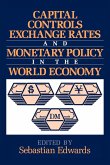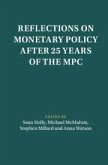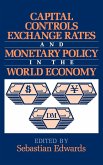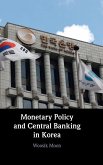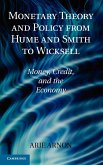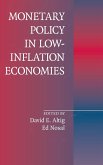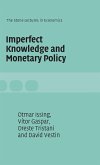The Political Economy of American Monetary Policy
Herausgeber: Mayer, Thomas
The Political Economy of American Monetary Policy
Herausgeber: Mayer, Thomas
- Broschiertes Buch
- Merkliste
- Auf die Merkliste
- Bewerten Bewerten
- Teilen
- Produkt teilen
- Produkterinnerung
- Produkterinnerung
An analysis of the role of the Federal Reserve in monetary policy making in the United States.
Andere Kunden interessierten sich auch für
![Capital Controls, Exchange Rates, and Monetary Policy in the World Economy Capital Controls, Exchange Rates, and Monetary Policy in the World Economy]() Sebastian Edwards (ed.)Capital Controls, Exchange Rates, and Monetary Policy in the World Economy45,99 €
Sebastian Edwards (ed.)Capital Controls, Exchange Rates, and Monetary Policy in the World Economy45,99 €![Reflections on Monetary Policy after 25 Years of the MPC Reflections on Monetary Policy after 25 Years of the MPC]() Reflections on Monetary Policy after 25 Years of the MPC111,99 €
Reflections on Monetary Policy after 25 Years of the MPC111,99 €![Capital Controls, Exchange Rates, and Monetary Policy in the World Economy Capital Controls, Exchange Rates, and Monetary Policy in the World Economy]() Capital Controls, Exchange Rates, and Monetary Policy in the World Economy121,99 €
Capital Controls, Exchange Rates, and Monetary Policy in the World Economy121,99 €![Monetary Policy and Central Banking in Korea Monetary Policy and Central Banking in Korea]() Woosik MoonMonetary Policy and Central Banking in Korea120,99 €
Woosik MoonMonetary Policy and Central Banking in Korea120,99 €![Monetary Theory and Policy from Hume and Smith to Wicksell Monetary Theory and Policy from Hume and Smith to Wicksell]() Arie ArnonMonetary Theory and Policy from Hume and Smith to Wicksell90,99 €
Arie ArnonMonetary Theory and Policy from Hume and Smith to Wicksell90,99 €![Monetary Policy in Low Inflation Economies Monetary Policy in Low Inflation Economies]() Monetary Policy in Low Inflation Economies89,99 €
Monetary Policy in Low Inflation Economies89,99 €![Imperfect Knowledge and Monetary Policy Imperfect Knowledge and Monetary Policy]() Vítor GasparImperfect Knowledge and Monetary Policy111,99 €
Vítor GasparImperfect Knowledge and Monetary Policy111,99 €-
-
-
An analysis of the role of the Federal Reserve in monetary policy making in the United States.
Produktdetails
- Produktdetails
- Verlag: Cambridge University Press
- Seitenzahl: 326
- Erscheinungstermin: 30. Mai 2014
- Englisch
- Abmessung: 229mm x 152mm x 18mm
- Gewicht: 474g
- ISBN-13: 9780521446518
- ISBN-10: 0521446511
- Artikelnr.: 22031098
- Herstellerkennzeichnung
- Libri GmbH
- Europaallee 1
- 36244 Bad Hersfeld
- gpsr@libri.de
- Verlag: Cambridge University Press
- Seitenzahl: 326
- Erscheinungstermin: 30. Mai 2014
- Englisch
- Abmessung: 229mm x 152mm x 18mm
- Gewicht: 474g
- ISBN-13: 9780521446518
- ISBN-10: 0521446511
- Artikelnr.: 22031098
- Herstellerkennzeichnung
- Libri GmbH
- Europaallee 1
- 36244 Bad Hersfeld
- gpsr@libri.de
Preface; 1. Introduction Thomas Mayer; 2. Studying the Fed: towards a
broader public choice perspective Thomas Willett; 3. The Federal Reserve
reaction function: a specification search Salwa Khouri; 4. Corporate
profitability as a determinant of restrictive monetary policy: estimates
for the post-war United States Gerald Epstein and Juliet Schor; 5. Federal
reserve behavior since 1980: a financial market perspective William Melton
and V. Vance Roley; 6. The Federal Reserve and its institutional
environment: a review Michael Munger and Brian Roberts; 7. The political
economy of monetary policy Robert Hetzel; 8. Political monetary cycles
Nathaniel Beck; 9. Congress and the Fed: Why the dog does not bark in the
night Nathaniel Beck; 10. The Federal Reserve as a political power James
Pierce; 11. Monetary policy and political economy: the Federal Reserve and
the Bank of Japan Thomas Cargill and Michael Hutchinson; 12. A positive
analysis of the policymaking process at the Federal Reserve Raymond Lombra
and Nicholas Karamouzis; 13. A theory of FOMC dissent voting with evidence
from the time series Thomas Havrilesky and Robert Schweitzer; 14.
Explaining FOMC members' votes John Gildea; 15. Fed behaviour and
X-efficiency theory: toward a general framework Harinder Singh and Roger
Frantz; 16. Minimizing regret: cognitive dissonance as an explanation of
FOMC behavior Thomas Mayer; 17. The discount window William Poole; 18.
Leaning against the wind: the behavior of the money stock in recession and
recovery, 1953-8 Elmus Wicker; 19. Bureaucratic self-interest as an
obstacle to monetary reform Edward Kane; Index.
broader public choice perspective Thomas Willett; 3. The Federal Reserve
reaction function: a specification search Salwa Khouri; 4. Corporate
profitability as a determinant of restrictive monetary policy: estimates
for the post-war United States Gerald Epstein and Juliet Schor; 5. Federal
reserve behavior since 1980: a financial market perspective William Melton
and V. Vance Roley; 6. The Federal Reserve and its institutional
environment: a review Michael Munger and Brian Roberts; 7. The political
economy of monetary policy Robert Hetzel; 8. Political monetary cycles
Nathaniel Beck; 9. Congress and the Fed: Why the dog does not bark in the
night Nathaniel Beck; 10. The Federal Reserve as a political power James
Pierce; 11. Monetary policy and political economy: the Federal Reserve and
the Bank of Japan Thomas Cargill and Michael Hutchinson; 12. A positive
analysis of the policymaking process at the Federal Reserve Raymond Lombra
and Nicholas Karamouzis; 13. A theory of FOMC dissent voting with evidence
from the time series Thomas Havrilesky and Robert Schweitzer; 14.
Explaining FOMC members' votes John Gildea; 15. Fed behaviour and
X-efficiency theory: toward a general framework Harinder Singh and Roger
Frantz; 16. Minimizing regret: cognitive dissonance as an explanation of
FOMC behavior Thomas Mayer; 17. The discount window William Poole; 18.
Leaning against the wind: the behavior of the money stock in recession and
recovery, 1953-8 Elmus Wicker; 19. Bureaucratic self-interest as an
obstacle to monetary reform Edward Kane; Index.
Preface; 1. Introduction Thomas Mayer; 2. Studying the Fed: towards a
broader public choice perspective Thomas Willett; 3. The Federal Reserve
reaction function: a specification search Salwa Khouri; 4. Corporate
profitability as a determinant of restrictive monetary policy: estimates
for the post-war United States Gerald Epstein and Juliet Schor; 5. Federal
reserve behavior since 1980: a financial market perspective William Melton
and V. Vance Roley; 6. The Federal Reserve and its institutional
environment: a review Michael Munger and Brian Roberts; 7. The political
economy of monetary policy Robert Hetzel; 8. Political monetary cycles
Nathaniel Beck; 9. Congress and the Fed: Why the dog does not bark in the
night Nathaniel Beck; 10. The Federal Reserve as a political power James
Pierce; 11. Monetary policy and political economy: the Federal Reserve and
the Bank of Japan Thomas Cargill and Michael Hutchinson; 12. A positive
analysis of the policymaking process at the Federal Reserve Raymond Lombra
and Nicholas Karamouzis; 13. A theory of FOMC dissent voting with evidence
from the time series Thomas Havrilesky and Robert Schweitzer; 14.
Explaining FOMC members' votes John Gildea; 15. Fed behaviour and
X-efficiency theory: toward a general framework Harinder Singh and Roger
Frantz; 16. Minimizing regret: cognitive dissonance as an explanation of
FOMC behavior Thomas Mayer; 17. The discount window William Poole; 18.
Leaning against the wind: the behavior of the money stock in recession and
recovery, 1953-8 Elmus Wicker; 19. Bureaucratic self-interest as an
obstacle to monetary reform Edward Kane; Index.
broader public choice perspective Thomas Willett; 3. The Federal Reserve
reaction function: a specification search Salwa Khouri; 4. Corporate
profitability as a determinant of restrictive monetary policy: estimates
for the post-war United States Gerald Epstein and Juliet Schor; 5. Federal
reserve behavior since 1980: a financial market perspective William Melton
and V. Vance Roley; 6. The Federal Reserve and its institutional
environment: a review Michael Munger and Brian Roberts; 7. The political
economy of monetary policy Robert Hetzel; 8. Political monetary cycles
Nathaniel Beck; 9. Congress and the Fed: Why the dog does not bark in the
night Nathaniel Beck; 10. The Federal Reserve as a political power James
Pierce; 11. Monetary policy and political economy: the Federal Reserve and
the Bank of Japan Thomas Cargill and Michael Hutchinson; 12. A positive
analysis of the policymaking process at the Federal Reserve Raymond Lombra
and Nicholas Karamouzis; 13. A theory of FOMC dissent voting with evidence
from the time series Thomas Havrilesky and Robert Schweitzer; 14.
Explaining FOMC members' votes John Gildea; 15. Fed behaviour and
X-efficiency theory: toward a general framework Harinder Singh and Roger
Frantz; 16. Minimizing regret: cognitive dissonance as an explanation of
FOMC behavior Thomas Mayer; 17. The discount window William Poole; 18.
Leaning against the wind: the behavior of the money stock in recession and
recovery, 1953-8 Elmus Wicker; 19. Bureaucratic self-interest as an
obstacle to monetary reform Edward Kane; Index.



